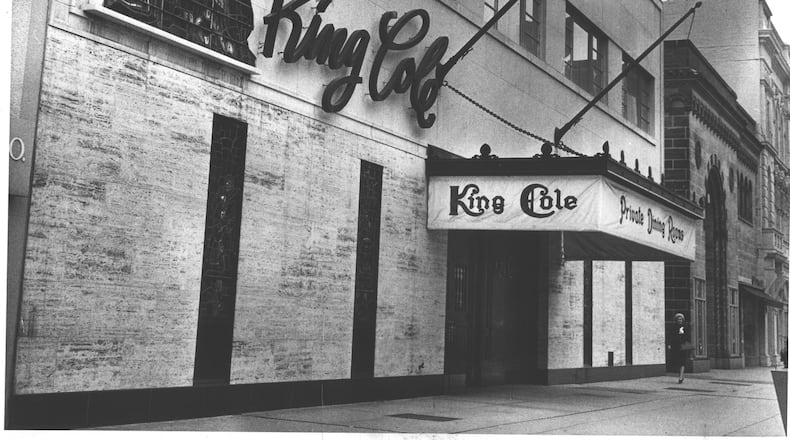Neil’s Heritage House
2189 S. Dixie Highway, Kettering.
Credit: Teesha Mcclam
Credit: Teesha Mcclam
Neil’s Heritage House opened in 1946 and quickly became a Dayton favorite. In 1994, the name changed to Neil’s Restaurant.
Neil’s offered fine food with a dress code of “dressy casual,” perfect for the cozy atmosphere of the Tenderloin Room or the French county casual décor of the main dining room.
House specialties included the popular roast prime rib of beef au jus, boneless breast of chicken supreme, daily fresh fish, baby back ribs, and more.
Happy hour, complemented by free hors d’oeuvres, was a highlight during the week.
The Savory
2335 Smithville Rd., Kettering
Credit: Dayton Daily News archives
Credit: Dayton Daily News archives
Mike Shampton and Fritz Montgomery opened the Savory in 1989 with a vision of bringing outstanding cuisine in a relaxed atmosphere to Dayton.
Dayton Daily News food critic Ann Heller chose The Savory as one of her Top 10 Restaurants for many years. In one of her reviews from 1990, she wrote: “Of the entrees we sampled, the thick veal chop served with a dollop of melting mustard butter was as good as I’ve had, and fresh — not frozen — New Zealand rack of lamb, cooked pink as we ordered, was trimmed of all fat and carved into single chops perfect for nibbling from the bone.”
The Savory featured some of the best fresh seafood, prime veal chops and chargrilled steaks in the Dayton area. It also featured a New Zealand rack of lamb and a variety of unique pasta dishes.
Despite its reputation for fine dining, The Savory was warm, inviting and never intimidating. The décor was upbeat and casual.
Kettering Village Inn
3910 Far Hills Ave., Kettering
The Kettering Village Inn was a Dayton landmark for more than 40 years, serving authentic Italian dishes to generations of Daytonians.
Kettering Village Inn advertised that they offered Italian specialties for every taste, everything from baked lasagna, jumbo scallops, veal parmigiana to chicken alfredo.
A 1972 Dayton Daily News review gave the restaurant an 8.1 out of 10 rating, saying, “The rating would’ve been higher had the price ($3.25) been lower. That’s a bit much for a ‘small’ pizza, even with sausage and pepperoni. (Fifty cents extra) for each added ingredient. The regular ‘small plain’ sells for $2.25.”
Eva Lewis worked at the Kettering Village Inn for 42 years. When she retired in 1994 at the age of 82, the restaurant decided it couldn’t go on without her and closed.
The Upper Krust
1919 N. Main St., Dayton
Credit: Skip Peterson/Dayton Daily News
Credit: Skip Peterson/Dayton Daily News
The original Upper Krust was founded by Jack Rouda. Owners Judith and Darrel Francis later took over the Upper Krust name and trademark.
Other locations included 6149 Far Hills Ave. in the Washington Square shopping center, and at one time there was one located at the old Salem Mall in Trotwood.
A reporter for the Dayton Daily news said in 2010, “The North Main Street deli had charm and character, and served up one fine sandwich in the Philadelphian, with its pastrami, corned beef and coleslaw stuffed between two slices of great rye bread.”
Suttmiller’s Restaurant
850 N. Main St., Dayton
Credit: NONE
Credit: NONE
Suttmiller’s was founded in 1947 by four brothers, Ted, Al, Bill and Cliff Suttmiller. It was a restaurant and nightclub featuring big-name entertainment and a house band. It closed in 1994.
Ted’s son, Tom, said in a 1997 Dayton Daily News article: “It was a place of great family feeling, where people knew the owners on a first-name basis ... There was a lot more personality in the business than you would find today.
“One of the biggest nights was Phyllis McGuire. She was a Middletown native, and there were just multitudes of people.”
In the restaurant’s lounge, Gardner Benedict presided over the piano bar, something he did for over 26 years.
Credit: DDN archive
Credit: DDN archive
Cliff Suttmiller said of their success in a 1988 Dayton Daily News article: “I think we succeeded ... because we always pushed our food, we do a big lunch business in addition to dinners and late-night dinners. The entertainment was a byproduct. We never had a cover charge except in a few extreme cases.”
Tropics
1721 N. Main St., Dayton
Credit: skip peterson
Credit: skip peterson
Tropics, founded by George Rudin, was one of Dayton’s most popular dine-and-dance spots for four decades.
Rudin built the place from a cozy cocktail lounge/delicatessen into one of the busiest restaurants in the U.S., with a seating capacity of 650. During the 1960s, Topics featured live music six nights a week.
Celebrities such as Rocky Marciano, Jane Mansfield, Cary Grant, Danny Kaye, Lucille Ball, Dean Martin, Jerry Lewis, Howard Cosell, Rita Moreno, Frankie Avalon and others dined there.
During the ‘70s it was more of a discotheque, and it closed in 1987.
The Peasant Stock
424 E. Stroop Rd., Kettering
Credit: JIM WITMER
Credit: JIM WITMER
The Peasant Stock was founded in 1977 by Dan Reinke and Don Walsh. It was sold to Chef David Glynn, who had been working for Reinke since 1988, in 1998.
It was a fixture in Kettering’s Town & County Shopping Center for more than 20 years. It was an attractive restaurant, vaguely French-looking, with skylights, hanging plants and stained glass.
The menu got away from the American steak and seafood standards and into international offerings such as Coq au vin, quiche and teriyaki with reasonably priced wines.
The Peasant Stock salad was one of the original restaurants signature offerings. The recipe was printed and shared many times over the years and was considered a hit when taken to potlucks.
Dominic’s Italian Restaurant
1066 Main St., Dayton
Credit: Jan Underwood
Credit: Jan Underwood
Dominic’s was founded by Dominic Mantia in 1957. Dick Mantia, Dominic’s son, took over the restaurant in the early 1960s when Dominic died. Dick died in 2002, and his wife, Anne, became sole proprietor in 2005.
Dominic’s was a popular dinner destination for UD fans, served UD teams pregame and postgame meals and offered a private room lined with Flyer sports photos and memorabilia.
Its reputation was for a consistent menu of traditional Italian dishes, sandwiches and pizza. The signature salad dressing, a garlicky vinegar and oil, was made from a secret family recipe.
Dominic’s was also known for turning away singer Liberace (they wouldn’t let him bring his dog in) and comedian Jerry Lewis (he wanted to eat in a room by himself on a busy night).
After over 50 years in business, the restaurant closed in 2007, was sold to Miami Valley Hospital and demolished.
Brown Derby
1911 N. Main St., Dayton
The Brown Derby was once one of Dayton’s finest fish houses.
It offered a menu which included red snapper, frog legs, oysters on the half shell, cherrystone clams, lobster thermidor and fresh fish, including imported Dover sole. Its “special baked potato” stuffed with cheese and garlic, was also very popular.
In a 1964 news article, it was said that “their 150-gallon salt water live lobster tank was the only one in this part of the state.”
The Brown Derby opened in 1945 and was owned by “Captain” John C. Smith for over 35 years before being sold to Gary Burkholder and Howard Woo, who also owned China Boy Restaurant. They changed the name of Brown Derby to “China Boy Central.”
The change in name opened the way for Brown Derby Inc. of Cleveland to move into the area. In late 1978, that chain of 45 family-style restaurants opened its first area Brown Derby in Oak Creek Plaza in Kettering.
King Cole
34 W. Second St., Dayton
Max Comisar founded the King Cole in 1953. He was known as the man who brought fine dining to Dayton when he opened the Seville restaurant in 1928.
Former Dayton Daily News food critic Ann Heller wrote that “King Cole ruled dining downtown in 1960s and early ‘70s.”
Dieter Krug, who was the chef there from 1963 until 1972 was quoted in the story as saying, “The King Cole was ‘the’ restaurant. It showed in the ratings of the day. In the ‘60s, Esquire magazine named it one of the nation’s 25 best restaurants.”
Its multiple dining rooms were filled with fine art and crystal chandeliers and could serve as many as 500. In the early days, the dress code called for men to wear jackets and for women to not wear slacks.
In January 1975, the restaurant moved to the Winters Bank/Kettering Tower building, now known as the Stratacache Tower. The relocation was required by the city due to a Courthouse Square project. The Winters/Kettering Tower location closed in 1998.
Help us with other restaurant memories
About the Author







